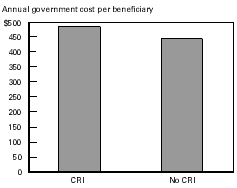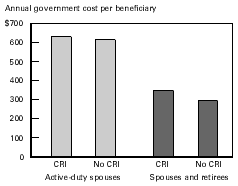Hospitals and clinics staffed primarily by military personnel shall provide health care to serving soldiers and, where possible, their dependants, as well as to retirees and their dependants.
When facilities are not available, health care for these civilians is provided by the Tricare program, formerly known as the Civilian Health and Medical Assistance Program (CHAMPUS). Until the late 1980s, CHAMPUS operated solely as a civilian indemnity insurance plan that reimbursed civilian caregivers for costs in excess of a certain deductible, less the beneficiaries’ deductibles.
In 1987, DOD proposed several reforms based in part on civilian health plans because civilian health care costs were rising rapidly and beneficiaries were dissatisfied with the program. The CHAMPUS Reform Initiative (CRI), in particular, offered beneficiaries the option of joining a network health maintenance organization (HMO) called CHAMPUS Prime. Through this initiative, DOD sought to reduce costs and improve beneficiary access and satisfaction.
It sought to achieve these goals by shifting some of the risk of cost increases to the civilian contractor, reducing deductibles and copayments in CHAMPUS Prime, and improving coverage for preventive care. Cost control mechanisms implemented by the civilian contractor included obtaining discounts from network physicians, extensive utilization review, and better coordination of care between CHAMPUS and military medical centers.
The IRC fundamentally changed the military health care system. Therefore, Congress required that the feasibility and cost-effectiveness of the initiative be verified before it is expanded. Congress also commissioned an independent evaluation by RAND. The five-year demonstration program began in 1988, and the evaluation covered the first two years.
The major findings of the evaluation are as follows:
- CRI did not reduce costs, but actually increased them by about 8%.
- IRC improved beneficiary access to health services and increased CHAMPUS Prime beneficiaries’ satisfaction with the program.
- Implementation of the initiative has not been easy, and problems with the full functioning of the new system may have limited its ability to control costs.
Costs
RAND compared cost trends and health care utilization in 11 health plan service areas in multistate health plans in California and Hawaii and in 11 similar areas in other states. These comparative controls ensured that the observed trends were not due to factors unrelated to CRI.
RAND surveyed approximately 29,000 beneficiaries just prior to the planned introduction of CRI and an additional 29,000 beneficiaries two years later. Respondents were asked about their recent use of health services. Based on the service use data, RAND analysts calculated the cost to the government per beneficiary of civilian health services, the operation of centralized military bases, and the administration of CHAMPUS.
For the average adult beneficiary, RAND estimated that state costs were 9% higher in areas with CRI than in areas without CRI (see Figure 1) [1] For the average child enrolled in CHAMPUS, RAND estimated that state costs were 6% higher. Weighting the average cost increases for adults and children yields the overall estimate of 8% shown above.

The 9% increase in adult costs is due solely to the Choice Prime program[2]. Prime members’ costs were 57% higher than the comparison group, CHAMPUS beneficiaries living outside of IRC areas. The costs of CRI beneficiaries who did not participate in the CRI were the same as those of the comparison group who did not participate in the CRI. There are also differences in costs by beneficiary group.
Spouses of active IRC beneficiaries had approximately the same bills as non-IRC beneficiaries; IRC retirees and their spouses had higher costs (see Figure 2). By budget or health care category, the higher costs for adult beneficiaries were primarily related to administrative costs; outpatient services were also slightly higher. CRI was able to reduce inpatient utilization in CHAMPUS compared to non-CRI and prevent at least a large increase in inpatient care in MTFs.
Is Prime’s failure to reduce costs related to the people involved? Unlike most HMOs, which may prioritize healthier-than-average clientele, the IRC contractor was responsible for the health of the entire CHAMPUS population in selected states. Therefore, it wanted to enroll less healthy people in the Prime program where they could be more intensively cared for. However, the insureds were no less healthy than those who were not enrolled in the Prime program. Worse, they were more likely to use the services of multinational hospitals, whose switch to more expensive civilian care could only increase costs, especially since the multinational hospitals had a vacancy in the Prime program.
Beneficiary satisfaction and access to care
Access to care and beneficiary satisfaction were measured using the same surveys that form the basis of the cost analysis. Analysis of the survey results showed that CHAMPUS Prime enrollees were half as likely as non-CKD CHAMPUS enrollees to have problems with access to care. They also received more preventive care.
Primary care recipients were more satisfied with all aspects of multinational health facilities than other recipients. Registered retirees and their spouses were more satisfied with all aspects of civilian care, while active duty spouses were more satisfied only with cost. More than 90% of Prime enrollees reported that they were at least as satisfied with CHAMPUS as they were before the CRI and that they would enroll in Prime again if they had to.
Those who were not enrolled in Prime were no more satisfied with most aspects of CHAMPUS than those who were not in CRI areas. However, they reported significantly fewer problems with using the military health care system.
Problems with implementation
Although all aspects of the initiative ultimately worked as planned, there were some significant problems early on. For example, it took only six months to establish a network of providers, market a reimbursement option to beneficiaries, and train staff on how to access cost-effective care options. This was not enough time. For example, it took nine months for Prime to become operational in two-thirds of MTSN service areas.
Another significant barrier was the failure of several key information systems. For example, the computer application system was not tested for real demand levels and proved unusable. Staff trained on the automated system had to be retrained to work in an inefficient manual mode. This had a negative impact on all operational aspects of the initiative. This gap deprived IRC leadership of the knowledge needed for marketing, costing, efficiency-based care decisions, and provider network development and training.
It has also led to an accumulation of complaints and to frustrated providers withdrawing from providing services. A significant proportion of claims took a year and a half to meet contractual requirements. Because the contractor was busy processing claims and managing provider networks, health service utilization and provider practices could not be actively monitored until two to three years after the demonstration program began.
Concluding Remarks
Based on experience in the civilian sector, DOD relied on managed care to control costs and ended up spending more in the first two years of the demonstration project. What went wrong?
- First, when a private employer uses an HMO, the group it serves – employees and dependents – is defined. DOD risked insuring all active duty spouses, retirees, and retired spouses, some of whom were not dependents of the military health care system when the IRC began. CHAMPUS Prime was attractive enough to persuade people who had previously used the more common civilian health insurance to make greater use of the military system, which allows a deductible.
- Second, although CHAMPUS Prime was able to assign primary care physicians to doctors at international military bases, most enrollees were assigned to civilian providers. Providers were generally more accessible, but this did not always prevent multinational companies from centralizing services. In the loosely coordinated environment of CRI, the MCHC was not always aware that these individuals needed to be directed elsewhere. As a result, for most Prime members, IRCs meant a wider range of potential sources of care (whereas most MCHCs tended to limit the sources of care available directly to their members).
- Third, these and other incentives to increase beneficiaries’ use of health care should be balanced by controls built into the system. In the case of IRCs, these controls included reforming the Office of Health Care Research to direct beneficiaries to cost-effective sources of care. These controls, of course, increase the cost of administering the plan, but HMOs have found that they achieve more than enough savings to offset the additional costs. In the case of CKD, however, monitoring was more complex because it had to account for both military and civilian systems. The uniqueness of the demonstration and the need to meet various regulatory requirements also increased costs. As noted earlier, systems supporting health care claimants and utilization review were not fully implemented during the evaluation period, eliminating potential savings from these activities.
Thus, the CHAMPUS reform initiative provided an expanded and cost-effective array of health care resources for beneficiaries and many people who had underutilized the system prior to the CRI. This was done without effective monitoring of service utilization or targeting of beneficiaries to the most cost-effective care settings. It is therefore not surprising that costs have risen. It is also not surprising that beneficiaries are very unhappy with this situation.
One of the lessons learned from the expansion of CRI and the implementation of other reforms is that the military health care system and civilian health care programs are complex functions. Merging the two programs requires detailed planning, recruiting and training appropriate staff to manage the new program, and testing and adapting many elements of processes and procedures. If too little time is devoted to either of these tasks, the goals of reform will be lost.
Comments
[Public spending in areas with CRI was 9% higher than it would have been in the absence of CRI, assuming that the spending trends observed in the benchmark areas applied to areas with CRI. All other comparisons presented here are detailed in the same way below.
[2] Insufficient data on children were available to determine a reliable distribution of costs.
Read our general and most popular articles
- Diaetoxil
- Nuubu
- Regener 8
- CBD Vital
- Nordic Oil
- Potencialex
- Diaetostat
- Figur Kapseln
- Viscerex
- Prostaphytol
- Nutra Prosta
- Nutra Flex
- Diaetolin
- Matcha Slim
- Hepafar Forte
- Derila Kissen
- Exodermin
- HHC
- HHC Vape
- KU2 Cosmetics Hyaluronsäure Serum
- Liba Capsules
- KetoXplode
- Green Gummies
- Liver Ignite
- Ketoxboom Fruchtgummis
- Viagra Alternative
- Gundry MD Energy Renew
- ProDentim
- Phentermine Over The Counter
David W. Newton is a board certified pharmacist and also has been a board member for boards of examiners for the National Association of Boards of Pharmacy since 1983. His areas of expertise are primarily pharmaceuticals as well as cannabinoids. You can read an article about his expertise in CBD on the National Library of Medicine.
Reviewed by: Kim Chin and Marian Newton

